.Net反向代理組件Yarp用法詳解
目錄
- 簡(jiǎn)介
- 基礎(chǔ)使用
- 1、創(chuàng)建 ASP.NET Core 空項(xiàng)目
- 2、 修改代碼 Program.cs 文件
- 3、修改配置文件 appsettings.json
- 4、啟動(dòng)項(xiàng)目
- 5、問(wèn)題整理
- 進(jìn)階探索
- 1、多地址代理
- 2、規(guī)則匹配
- 3、問(wèn)題整理
- 小試牛刀
- 踩坑集錦
- 1、non-ASCII
簡(jiǎn)介
Yarp 是微軟團(tuán)隊(duì)開(kāi)發(fā)的一個(gè)反向代理組件, 除了常規(guī)的 http 和 https 轉(zhuǎn)換通訊,它最大的特點(diǎn)是可定制化,很容易根據(jù)特定場(chǎng)景開(kāi)發(fā)出需要的定制代理通道。
詳細(xì)介紹:https://devblogs.microsoft.com/dotnet/announcing-yarp-1-0-release
源碼倉(cāng)庫(kù):https://github.com/microsoft/reverse-proxy
文檔地址 :https://microsoft.github.io/reverse-proxy/
基礎(chǔ)使用
1、創(chuàng)建 ASP.NET Core 空項(xiàng)目
使用 Visual Studio :

使用 .NET CLI 命令行創(chuàng)建:
dotnet new web -o MyProxy
2、 修改代碼 Program.cs 文件
var builder = WebApplication.CreateBuilder(args);builder.Services.AddReverseProxy() .LoadFromConfig(builder.Configuration.GetSection("ReverseProxy"));var app = builder.Build();app.MapGet("/Ping", () => "Hello World!");app.MapReverseProxy();app.Run();3、修改配置文件 appsettings.json
{ "Logging": { "LogLevel": { "Default": "Information", "Microsoft.AspNetCore": "Warning" } }, "AllowedHosts": "*", "ReverseProxy": { "Routes": { "routeAll": {"ClusterId": "clusterBaidu","Match": { "Path": "{**catch-all}"} } }, "Clusters": { "clusterBaidu": {"Destinations": { "baidu": { "Address": "https://www.baidu.com/" }} } } }}這里的配置是將所有的請(qǐng)求都轉(zhuǎn)發(fā)到百度。
在 Program.cs 里,還注冊(cè)了一個(gè) Get 路由 Ping 。
4、啟動(dòng)項(xiàng)目
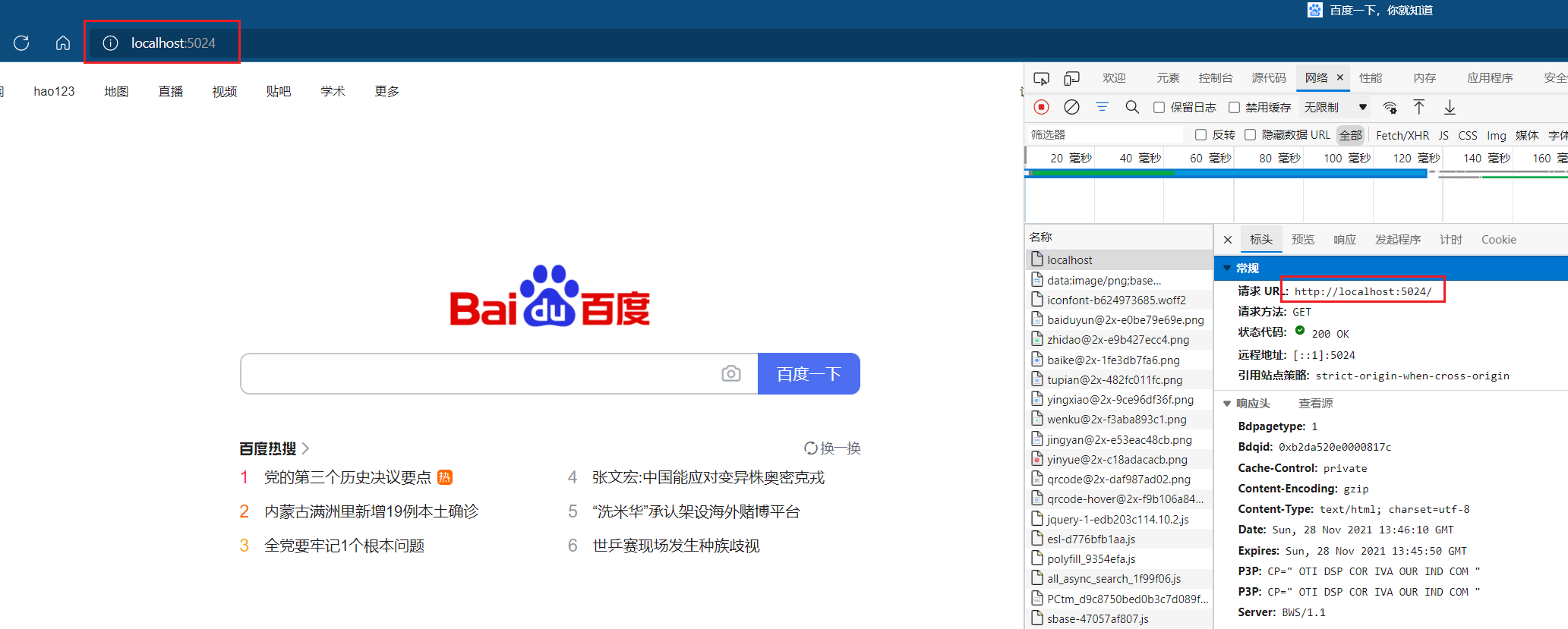
能夠看到在瀏覽器訪問(wèn)程序監(jiān)聽(tīng)的端口號(hào)后,顯示的是百度的頁(yè)面。打開(kāi) F12 ,看到請(qǐng)求頭也是本地的,并不是百度的域名。
測(cè)試手動(dòng)注冊(cè)的路由 Ping :
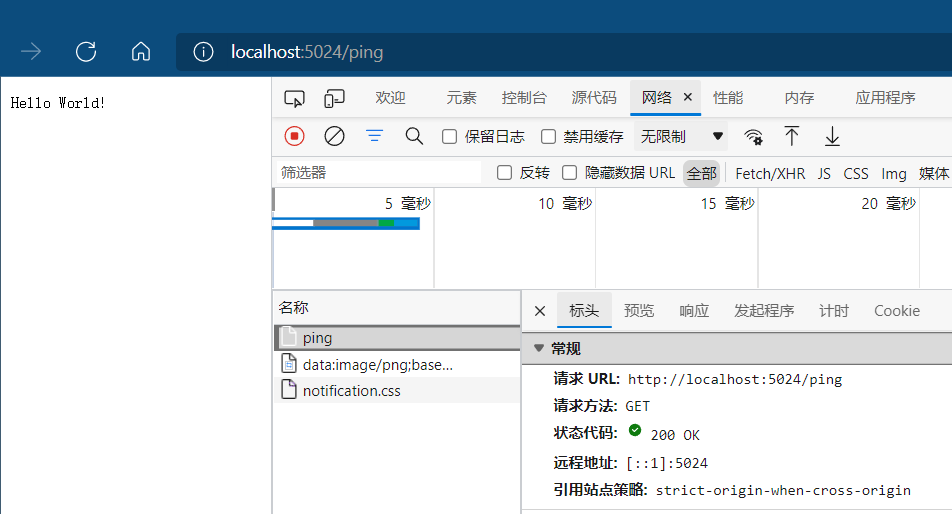
能夠顯示正常。
5、問(wèn)題整理
- (1) Yarp 是不是只能做這種簡(jiǎn)單的轉(zhuǎn)發(fā)?
不是,往下有配置文件說(shuō)明。
- (2) JSON 配置文件里有什么要注意的地方嗎?
有。在這個(gè)演示的配置文件中 ReverseProxy:Clusters:cluster1:Destinations:destination1:Address 對(duì)應(yīng)的值是:https://www.baidu.com/ ,如果去掉 www ,在項(xiàng)目啟動(dòng)后會(huì)跳轉(zhuǎn)到百度首頁(yè),不是代理轉(zhuǎn)發(fā)。去掉末尾的 / 符合沒(méi)有任何影響。
- (3) Yarp 會(huì)影響到程序中注冊(cè)的路由嗎?
不會(huì)影響到程序內(nèi)部注冊(cè)的路由。在 Program.cs 中無(wú)論 app.MapReverseProxy(); 在上還是在下,在訪問(wèn) Ping 的時(shí)候,都是返回 Hello World!
var app = builder.Build();app.MapReverseProxy();app.MapGet("/Ping", () => "Hello World!");app.Run();進(jìn)階探索
1、多地址代理
修改配置文件 appsettings.json ,實(shí)現(xiàn)默認(rèn)路由跳轉(zhuǎn)百度,當(dāng)訪問(wèn) /movie 是訪問(wèn) b站。
{ "Logging": { "LogLevel": { "Default": "Information", "Microsoft.AspNetCore": "Warning" } }, "AllowedHosts": "*", "ReverseProxy": { "Routes": { "routeBaidu": {"ClusterId": "clusterBaidu","Match": { "Path": "{**catch-all}"} }, "routeBiliBili": {"ClusterId": "clusterBiliBili","Match": { "Path": "/movie/{**catch-all}"} } }, "Clusters": { "clusterBaidu": {"Destinations": { "baidu": { "Address": "https://www.baidu.com/" }} }, "clusterBiliBili": {"Destinations": { "bilibili": { "Address": "https://www.bilibili.com/" }} } } }}測(cè)試結(jié)果:


在后面輸入路由 /movie 后能夠跳轉(zhuǎn)到b站。但是b站網(wǎng)頁(yè)沒(méi)有完整顯示,圖片都沒(méi)有,這是網(wǎng)站上的策略問(wèn)題,對(duì)于數(shù)據(jù)接口沒(méi)有這些問(wèn)題。
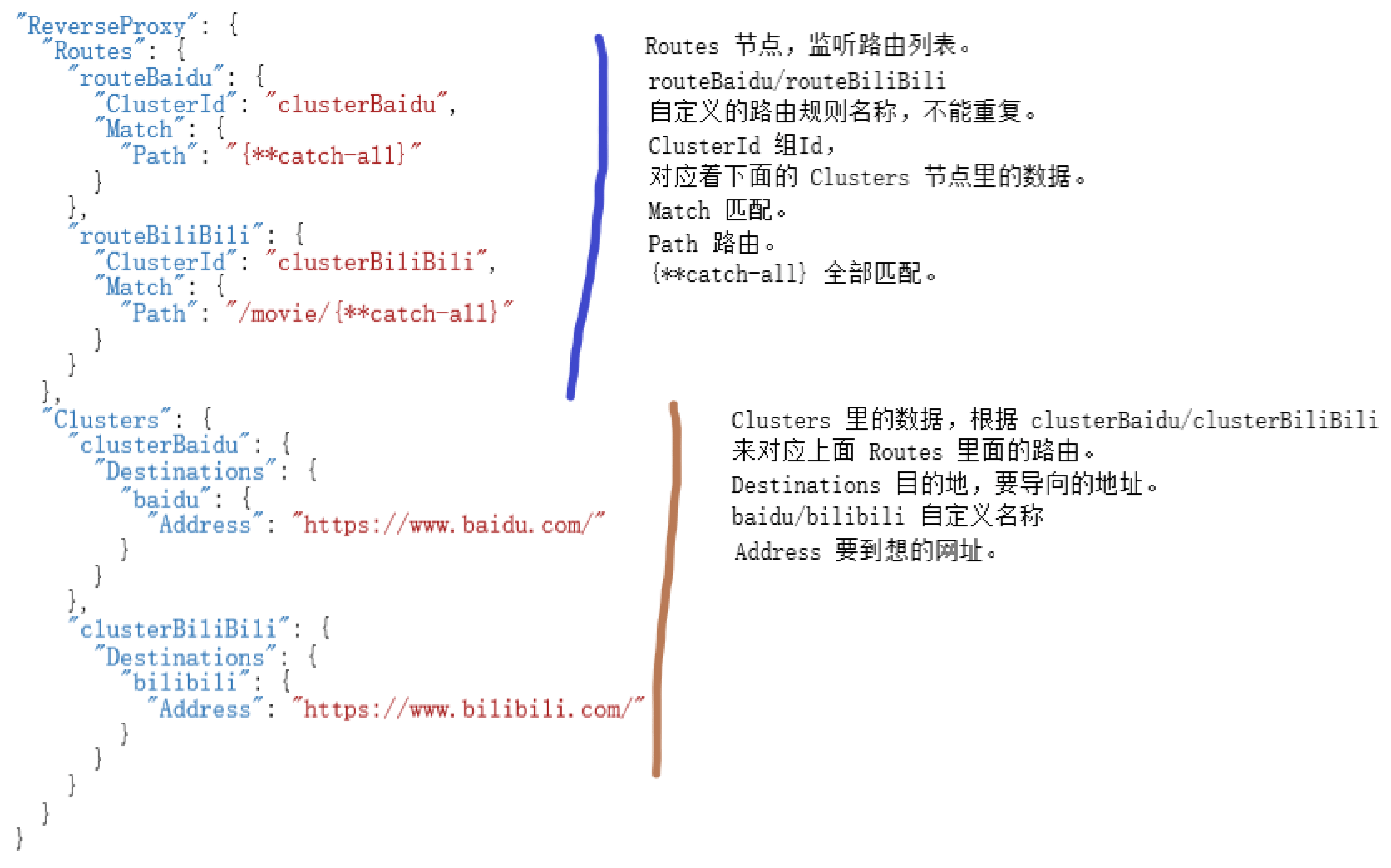
詳細(xì)的配置文件說(shuō)明,可以查看 https://microsoft.github.io/reverse-proxy/articles/config-files.html
2、規(guī)則匹配
網(wǎng)頁(yè)上太多資源,為了方便測(cè)試,啟用兩個(gè) api 接口。地址分別是:http://localhost:5241/ 和 https://localhost:7184/
兩個(gè) api 接口中分別注冊(cè) /test 路由。
// http://localhost:5241/app.MapGet("/test", () => "Welcome to Api111!");// https://localhost:7184/app.MapGet("/test", () => "Welcome to Api222!");啟動(dòng)兩個(gè) api 程序。
C:\Users\Test>curl http://localhost:5241/testWelcome to Api111!C:\Users\Test>curl https://localhost:7184/testWelcome to Api222!
修改 MyProxy 項(xiàng)目的配置文件 appsettings.json
{ "Logging": { "LogLevel": { "Default": "Information", "Microsoft.AspNetCore": "Warning" } }, "AllowedHosts": "*", "ReverseProxy": { "Routes": { "routeOne": {"ClusterId": "clusterOne","Match": { "Path": "/test/{**catch-all}", "QueryParameters": [ { "Name": "number", "Values": [ "1" ] } ]} }, "routeTwo": {"ClusterId": "clusterTwo","Match": { "Path": "/test/{**catch-all}", "QueryParameters": [ { "Name": "number", "Values": [ "2" ] } ]} }, "routeBaidu": {"ClusterId": "clusterBaidu","Match": { "Path": "{**catch-all}"} } }, "Clusters": { "clusterOne": {"Destinations": { "apiOne": { "Address": "http://localhost:5241/" }} }, "clusterTwo": {"Destinations": { "apiTwo": { "Address": "https://localhost:7184/" }} }, "clusterBaidu": {"Destinations": { "baidu": { "Address": "https://www.baidu.com/" }} } } }}- Path :監(jiān)聽(tīng)路由地址。
- QueryParameters:匹配參數(shù)。
- QueryParameters:Name:參數(shù)名。
- QueryParameters:Values:參數(shù)值。
MyProxy 的監(jiān)聽(tīng)端口是 http://localhost:5024/ 訪問(wèn)結(jié)果如下:
C:\Users\Test>curl http://localhost:5024/pingHello World!C:\Users\Test>curl http://localhost:5024/test<!DOCTYPE HTML PUBLIC "-//IETF//DTD HTML 2.0//EN"><html><head><title>404 Not Found</title></head><body><h1>Not Found</h1><p>The requested URL /test was not found on this server.</p></body></html>C:\Users\Test>curl http://localhost:5024/test?number=1Welcome to Api111!C:\Users\Test>curl http://localhost:5024/test?number=2Welcome to Api222!
能夠根據(jù)參數(shù)以及參數(shù)值導(dǎo)向?qū)?yīng)的地址。
3、問(wèn)題整理
- (1)為什么訪問(wèn) /movie 不能正常顯示網(wǎng)頁(yè)。
因?yàn)?b站某些接口開(kāi)啟了防盜鏈,還有跨域檢測(cè)。
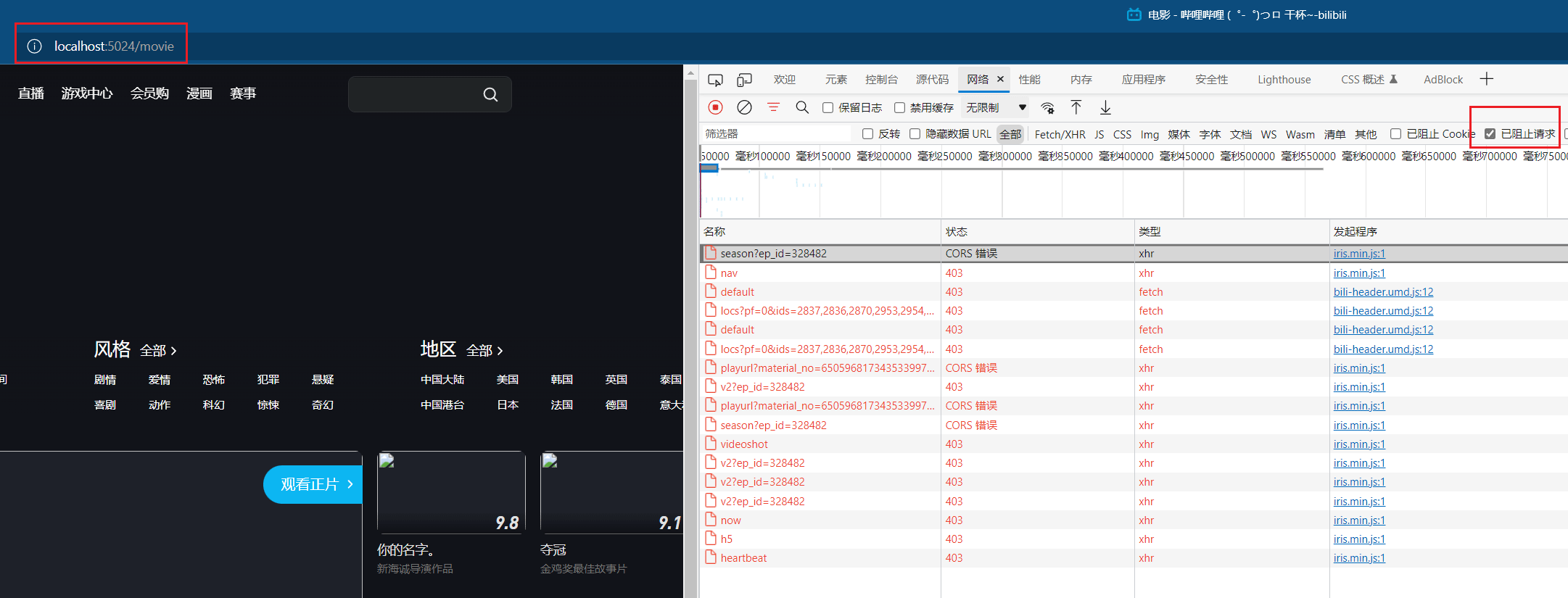
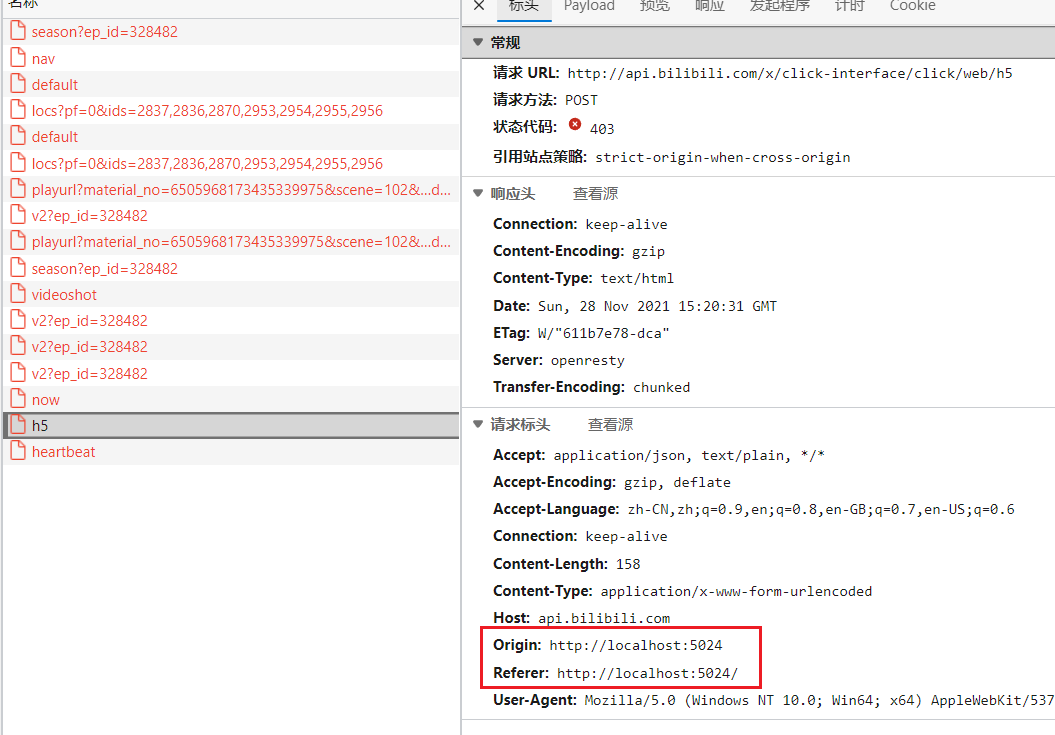
- (2)在根據(jù)參數(shù)匹配中,如果匹配的路由一樣,監(jiān)聽(tīng)的參數(shù)一樣,參數(shù)值也一樣會(huì)怎么樣?
訪問(wèn)該路由地址會(huì)報(bào)錯(cuò)。
- (3)路由匹配的優(yōu)先級(jí)?
程序內(nèi)注冊(cè)的路由優(yōu)先級(jí)最高,其次才是 Yarp 在配置文件里加載的。
小試牛刀
最近的工作是做企業(yè)內(nèi)數(shù)據(jù)安全方面的。推動(dòng)公司數(shù)據(jù)安全體系,通過(guò)技術(shù)手段提升公司信息安全。
有一個(gè)很老的OA系統(tǒng),十幾年了, .NET Framework 2.0 寫(xiě)的。漏洞一大堆,包括不限于xss、sql注入等,權(quán)限只到表單級(jí)別。瀏覽器上按下 F12 能查看到表單鏈接,直接復(fù)制出去,別人也能訪問(wèn)。
在這個(gè)系統(tǒng)上要做安全,我想的是在中間加代理,正好適合使用 Yarp 來(lái)完成,也方便寫(xiě)業(yè)務(wù)處理代碼。嗯,很真實(shí), .NET Core 寫(xiě)的,方便寫(xiě)業(yè)務(wù)代碼。
用戶登錄成功后,會(huì)記錄下用戶的 Host 和 Cookie,每次訪問(wèn)的時(shí)候系統(tǒng)的時(shí)候,在 Yarp 這里都校驗(yàn)一下是否與用戶登錄時(shí)的匹配。
解決了兩個(gè)問(wèn)題:
1、從網(wǎng)絡(luò)層捕獲到所有的請(qǐng)求,方便后面做排查。參數(shù)、傳值,出了事故可以找到責(zé)任人。
2、隔離真實(shí)的站點(diǎn)地址,杜絕弱安全等級(jí)網(wǎng)站暴露后被壞人攻擊的風(fēng)險(xiǎn)。
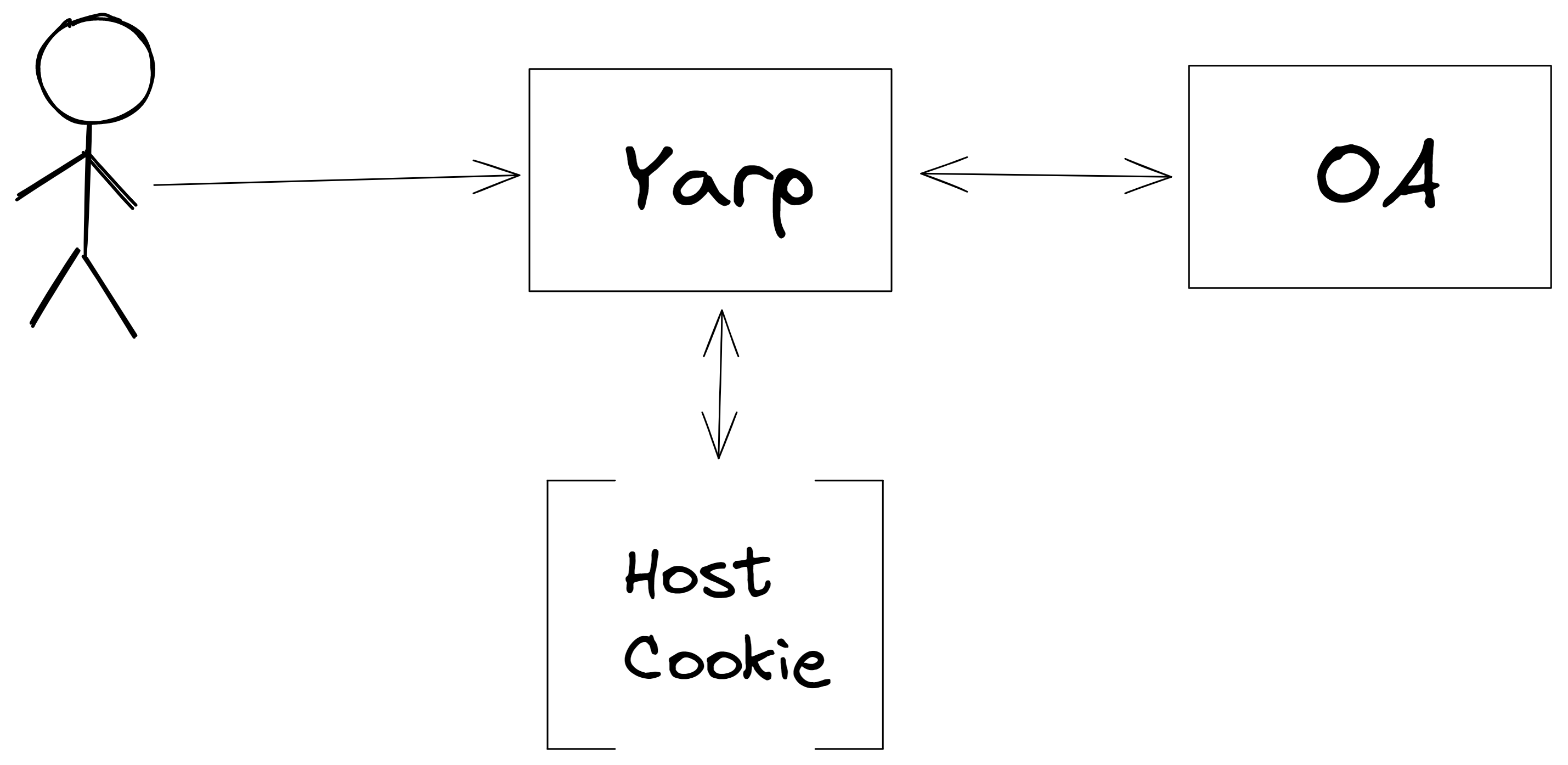
踩坑集錦
1、non-ASCII
項(xiàng)目要代理某網(wǎng)頁(yè),在使用下載功能的時(shí)候,接口返回 502 。
info: Yarp.ReverseProxy.Forwarder.HttpForwarder[48] ResponseHeaders: The destination returned a response that cannot be proxied back to the client. System.InvalidOperationException: Invalid non-ASCII or control character in header: 0x00E4 at Microsoft.AspNetCore.Server.Kestrel.Core.Internal.Http.HttpHeaders.ThrowInvalidHeaderCharacter(Char ch) at Microsoft.AspNetCore.Server.Kestrel.Core.Internal.Http.HttpHeaders.ValidateHeaderValueCharacters(StringValues headerValues) at Microsoft.AspNetCore.Server.Kestrel.Core.Internal.Http.HttpResponseHeaders.SetValueFast(String key, StringValues value) at Microsoft.AspNetCore.Server.Kestrel.Core.Internal.Http.HttpHeaders.Microsoft.AspNetCore.Http.IHeaderDictionary.set_Item(String key, StringValues value) at Yarp.ReverseProxy.Forwarder.HttpTransformer.CopyResponseHeaders(HttpHeaders source, IHeaderDictionary destination) at Yarp.ReverseProxy.Forwarder.HttpTransformer.TransformResponseAsync(HttpContext httpContext, HttpResponseMessage proxyResponse) at Yarp.ReverseProxy.Transforms.Builder.StructuredTransformer.TransformResponseAsync(HttpContext httpContext, HttpResponseMessage proxyResponse) at Yarp.ReverseProxy.Forwarder.HttpForwarder.SendAsync(HttpContext context, String destinationPrefix, HttpMessageInvoker httpClient, ForwarderRequestConfig requestConfig, HttpTransformer transformer)
去 GitHub 翻 Issues

下載接口能正常訪問(wèn),文件流也能完整地拿到。重寫(xiě)了所有的響應(yīng)頭沒(méi)有用。這種不開(kāi)源的商業(yè)站點(diǎn),也猜不到字符編碼。
最后妥協(xié)了,用了一個(gè) .NET 服務(wù)在服務(wù)器上下載后再轉(zhuǎn)發(fā)。
代理非常規(guī)服務(wù)接口時(shí),一定要多測(cè)試。
以上就是這篇文章的全部?jī)?nèi)容了,希望本文的內(nèi)容對(duì)大家的學(xué)習(xí)或者工作具有一定的參考學(xué)習(xí)價(jià)值,謝謝大家對(duì)的支持。如果你想了解更多相關(guān)內(nèi)容請(qǐng)查看下面相關(guān)鏈接
相關(guān)文章:
1. ASP.NET Core按用戶等級(jí)授權(quán)的方法2. ASP.NET MVC通過(guò)勾選checkbox更改select的內(nèi)容3. .NET SkiaSharp 生成二維碼驗(yàn)證碼及指定區(qū)域截取方法實(shí)現(xiàn)4. ASP.NET Core實(shí)現(xiàn)中間件的幾種方式5. .NET API 接口數(shù)據(jù)傳輸加密最佳實(shí)踐記錄6. .NET 中配置從xml轉(zhuǎn)向json方法示例詳解7. 使用.net core 自帶DI框架實(shí)現(xiàn)延遲加載功能8. .net如何優(yōu)雅的使用EFCore實(shí)例詳解9. .Net中的Http請(qǐng)求調(diào)用詳解(Post與Get)10. 使用EF Code First搭建簡(jiǎn)易ASP.NET MVC網(wǎng)站并允許數(shù)據(jù)庫(kù)遷移

 網(wǎng)公網(wǎng)安備
網(wǎng)公網(wǎng)安備